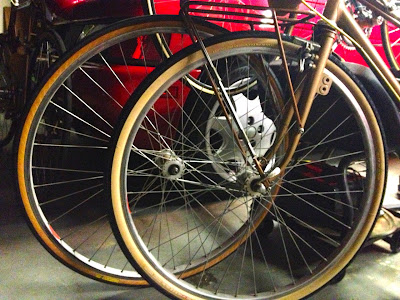I've decided to stop grumbling about the bad roads and refit shorter, fatter tires on my tandem. They are called 650B rather than 700C (normal size nowadays) or 27 inch (normal size in the past). On a normal bike, we are limited in what we can change because the chain stays or fork might be too narrow, or the brakes wouldn't adjust to the new wheels. And then we'd have to spend a fortune - let's say a grand - on new wheels, tires, brakes, etc. and possibly frame alterations.
When I built our tandem I planned for this. I made sure the frame would fit. I built another set of wheels. So last week I hunted around the bike mail order world, ordered new tires and waited for the big brown delivery truck to drop them off.
They arrived this evening, along with new tubes and some Phil hand cleaner (marvelous stuff - try it). I mounted up the tires and set about the conversion. In the photo below you can see a 27" clincher tire on the left, a 700C tubular on the right, and the new 650B in the center.
Here's a better look so you can see the difference in width and tread between the three tires.
As you can see in this picture, there is not much room between the new tire and the diagonal stays. The chain stays are tight too. But there is room as long as I don't try to squeeze a big fender in there.
Tomorrow I will shift the brake pivots down. As you can see in the photo below, the current brakes are mounted on the upper cantilever pivot. I will remove the Allen bolt in the bottom hole, move the pivots and brake arms down an inch, and put the Allen bolt in the top hole to keep out water and debris. I will also have to adjust the pads a bit and lengthen the main or saddle wires since the brakes will be lower (farther from the brake handles).
I also need to move the Phil disc brake from one rear wheel to the other. That simply means pulling a circlip, sliding the caliper off, putting it onto the new wheel's splined driver, reinstalling the circlip and putting the wheel back into the frame and connecting the cable.
Brake on the old wheel. This design uses a completely enclosed brake disc. It's made of friction material rather than metal. The caliper squeezes down on the friction disc and slows the bike. It's an elegant design and has worked flawlessly for me, although others had problems. I use it as a parking brake or a drag brake, and operate it from a fingertip shifter, NOT the brake handles.
"New" 650B wheel with splined driver for the disc brake.
PS - the fork tab upon which we bolt our lighting generator has two holes so we can drive the generator with 650B wheels. Did you notice that in the first photo?
MUSTANG CONVERTIBLES
Yes. One silver, one blue. Here's the silver one.
And I found a very rare green/gold version of the Honda Insight Hybrid. My blue car is the other one in the photo. I just drove up, stopped in the middle of the road, got out, took the photo, and drove off. Why not?








